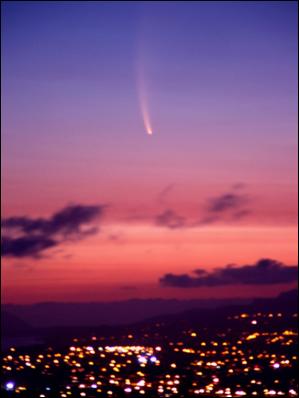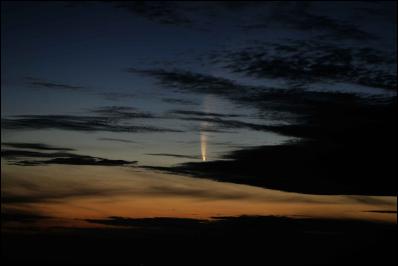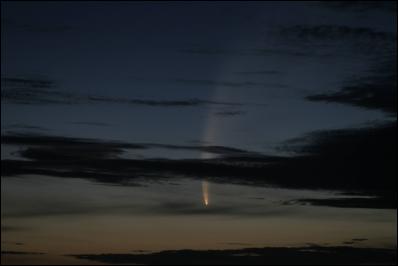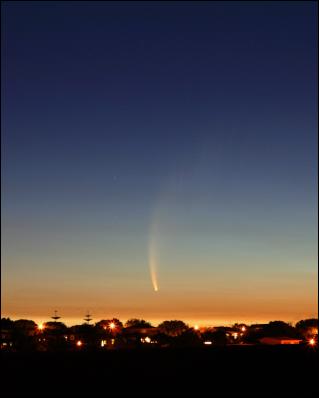Your Images: New Zealanders Submit Amazing Images Of Comet McNaught
With clear and cool southern skies proving perfect for star-gazing, New Zealanders have been out comet spotting and capturing images of Comet McNaught as it passes by Earth. Comet C/2006 P1 (McNaught) was discovered by Australian astronomer Rob McNaught at Siding Springs Observatory on August 7, 2006. At this point it was still 525 million kilometres from the Sun and very faint. That is twice the distance of Mars.
***
Bren Harrison - This photo of Comet McNaught was submitted to Scoop by Bren Harrison of Auckland, taken on 18th Jan 2007 from the top of the dormant volcano Mt Eden in the heart of Auckland City, New Zealand.

Click for big version – Image by Bren Harrison, Mt Eden, Auckland.
Chas, submitted the following two images that were taken from Princess Bay, Wellington, Thursday 18 January 2007 at 10.12pm. He says it was quite a cloudy evening and had to wait a from 9.20pm for the Comet to drop into view,well worth the wait!! And for you techo's: it was shot with a Canon EOS20D, ISO200, 125mm Lens, F/5.0, 6.0secs exposure,

Click for big version - Image by Chas, Princess Bay, Wellington.

Click for big
version – Image by Chas, Princess Bay,
Wellington.
***
David Clark
submitted this image of Comet McNaught, taken Thursday 18
January at
9pm. David writes: This was taken from the
roof of my house in St Heliers, Auckland, and shows the
stunning comet - the brightest seen for decades. I used a
standard digital camera (Canon EOS 350D)

Click for big version – Image: David Clark, St Helliers, Auckland.
Text by Stardome Observatory - Comet C/2006 P1 (McNaught) was discovered by Australian astronomer Rob McNaught at Siding Springs Observatory on August 7, 2006. At this point it was still 525 million kilometres from the Sun and very faint. That is twice the distance of Mars.
The comet continued to brighten as it approached the Sun but became lost in the Sun's glare during December and was not sighted again until Boxing Day. It brightened sharply leading up January 13th when it passed within 25 million kilometres of the Sun, half the distance of the innermost planet, Mercury.
This placed the comet on the "sun-grazer" category and a prime candidate to be split apart by the Sun's gravitational pull.
Over the next week, the comet will continue to move up the sky and remain visible longer after sunset. The brightness changes of comets are notoriously hard to predict but unless it suddenly starts ejecting more dust and gas, it will steadily fade over the coming week.



 Binoy Kampmark: Fallibility, Dirty Wars And Pope Francis I
Binoy Kampmark: Fallibility, Dirty Wars And Pope Francis I Peter Dunne: Dunne's Weekly - An Issue No-one Can Afford To Lose
Peter Dunne: Dunne's Weekly - An Issue No-one Can Afford To Lose Martin LeFevre - Meditations: Choosing Mass Murder?
Martin LeFevre - Meditations: Choosing Mass Murder? Eugene Doyle: Quiet Mutiny - The U.S. Army Falls Apart
Eugene Doyle: Quiet Mutiny - The U.S. Army Falls Apart Gordon Campbell: Papal Picks, And India As A Defence Ally
Gordon Campbell: Papal Picks, And India As A Defence Ally Binoy Kampmark: The Selling Of America - Ending The US Dollar’s Exorbitant Privilege
Binoy Kampmark: The Selling Of America - Ending The US Dollar’s Exorbitant Privilege